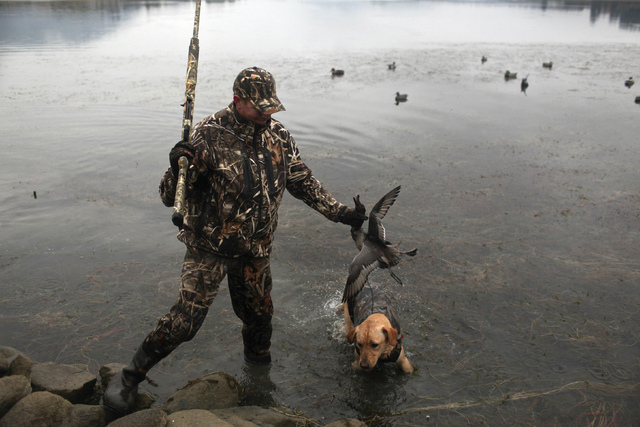Duck hunters pray for bad weather

When describing waterfowl hunting in Southern Nevada this year, emphasis probably could be placed on the hunting part of the equation.
Unseasonably warm temperatures and mild weather conditions have birds holding in areas of open water further to the north, water that should be frozen over about now or close to it. And that has dedicated duck hunters praying for a little bad weather to get birds moving this way.
The “full moon and warmer temps have not been a good combination for duck hunting this week,” wrote Travis Madden, a member of the Avery Pro Staff and field reporter for Ducks Unlimited of Orem, Utah. “Weather continues to be in the mid-40s during the daytime. Water is open again, and the ice is gone. We need some more weather bad!” he added to his migration report Tuesday.
Conditions are similar on the Nevada side of the migration corridor, where daytime temperatures in the mid-50s have reservoirs at the Kirch Wildlife Management Area ice-free. Tim Wood, manager of the Overton Wildlife Management Area, said dedicated hunters are putting in the time and effort, but the reward for their efforts is a day in the outdoors rather than a limit of ducks. He also is hoping for a change in the weather.
Perhaps that change is on its way. A cold front is expected to blow through central and northern Nevada today, according to the National Weather Service forecast. Winds strong enough to call for an advisory are expected first, and those will be followed by rain turning into snow showers by Friday. Further north, snow is expected a little sooner.
Speaking of change, waterfowl hunters might see an increase in the cost of their Federal Migratory Bird Hunting and Conservation Stamp next year. This stamp is most commonly known as a Duck Stamp.
On Dec. 2, the U.S. Senate passed the Federal Duck Stamp Act of 2014, which calls for an increase from the current rate of $15 per stamp to $25. The bill was presented to the president for his consideration on Dec. 8.
Ducks Unlimited is calling the increase a major win for wetlands and waterfowl conservation. Ducks Unlimited CEO Dale Hall said: “The additional duck stamp funding provided by waterfowl hunters and other conservationists will not only conserve critical waterfowl habitat but will also help ensure the future of our waterfowling traditions.”
The last increase in the price of a Federal Duck Stamp was 1991. Since that time, according to Ducks Unlimited, inflation and rising land costs have diminished the purchasing power of funds raised by sale of the stamp. Hence the need for a price increase.
The Federal Duck Stamp was first created with passage of the Migratory Bird Hunting Stamp Act in 1934 as the means of generating funding for the conservation of migrating waterfowl and their habitat. All waterfowl hunters age 16 or older must carry a federal duck stamp in addition to their state hunting license.
“Ninety-eight cents out of every dollar generated by the sale of Federal Duck Stamps goes directly to purchase or lease wetland habitat for protection in the National Wildlife Refuge System,” according to the U.S. Fish and Wildlife Service. “Sales of Federal Duck Stamps have generated more than $800 million, which has been used to purchase or lease over 6 million acres of wetlands habitat in the United States.”
Sen. David Vitter of Louisiana called passage of the Stamp Act “huge news for conservation and duck hunters. … As we move forward to conserve millions of acres of waterfowl habitat, it’s important to remember the mutually beneficial relationship between our nation’s sportsmen and ducks.”
Freelance writer Doug Nielsen is a conservation educator for the Nevada Department of Wildlife. His “In the Outdoors” column, published Thursday in the Las Vegas Review-Journal, is not affiliated with or endorsed by the NDOW. Any opinions he states in his column are his own. He can be reached at intheoutdoorslv@gmail.com.